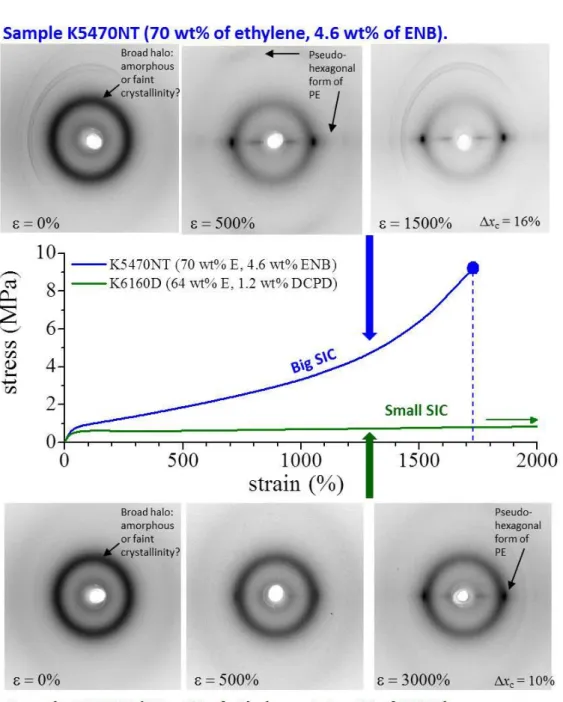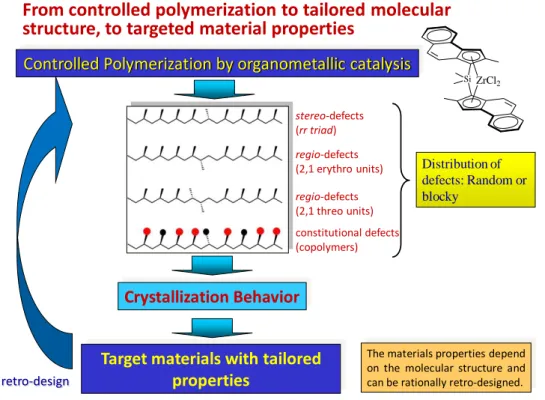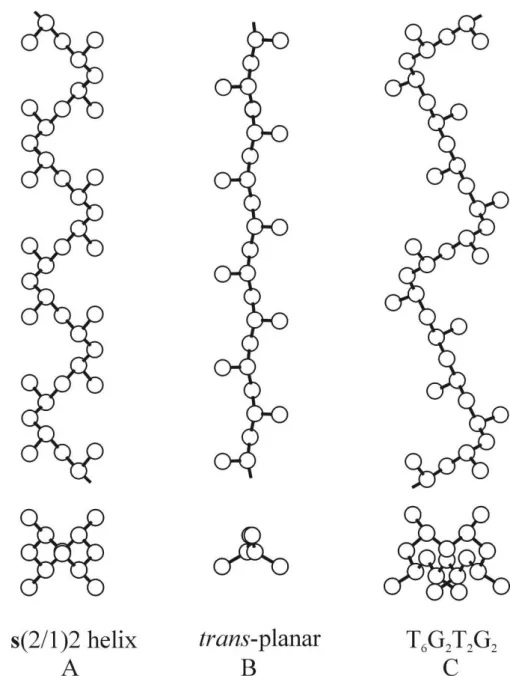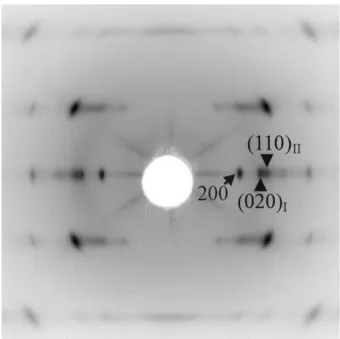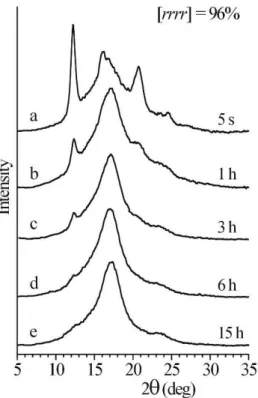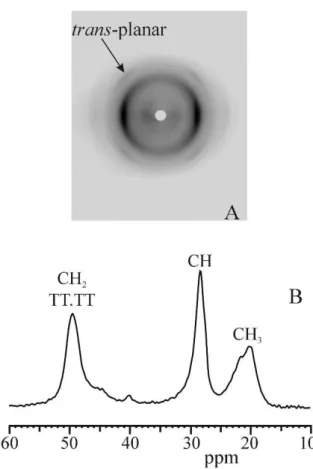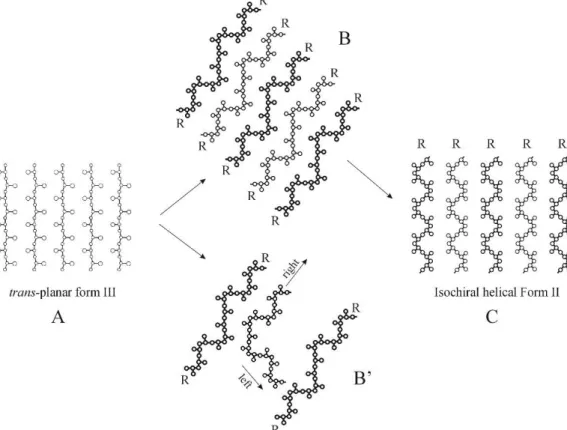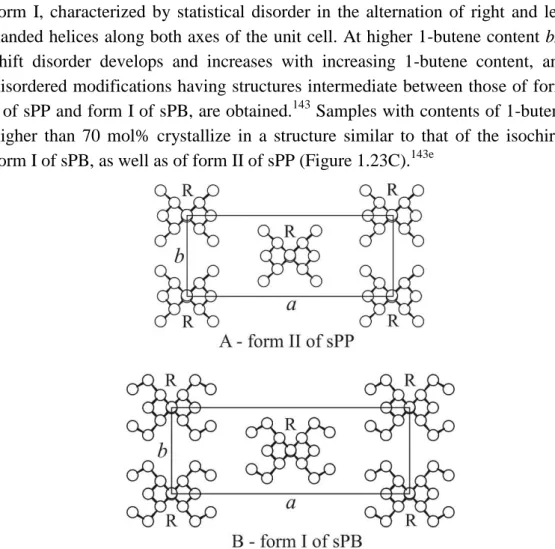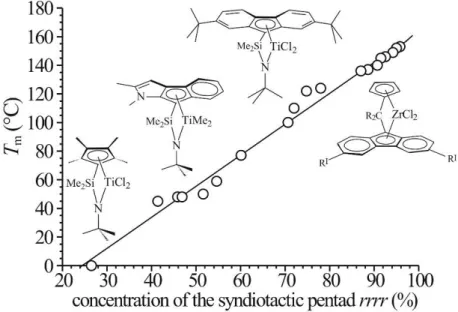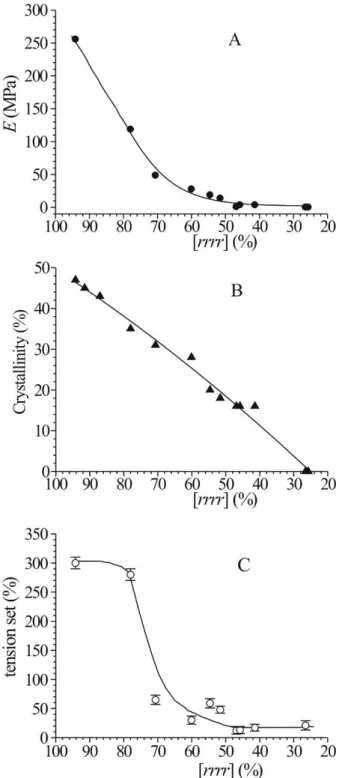UNIVERSITÀ DEGLI STUDI DI NAPOLI
FEDERICO II
CHEMISTRY SCIENCE DOCTORATE
XXX CYCLE
Novel polyolefin based elastomers with tailored
stiffness from metallorganic catalysis: the
crystalline elastomers
TUTORS:
Prof. Claudio De Rosa
Prof. Finizia Auriemma
CANDIDATE:
Miriam Scoti
UNIVERSITÀ DEGLI STUDI DI NAPOLI
FEDERICO II
DOTTORATO DI RICERCA IN SCIENZE CHIMICHE
XXX CICLO
Nuovi elastomeri a base di poliolefine a rigidità
controllata da catalisi organometallica: gli
elastomeri cristallini
TUTORI:
Prof. Claudio De Rosa
Prof. Finizia Auriemma
CANDIDATA:
Miriam Scoti
Index
Summary S1-S13
Introduction 1
Chapter I. Syndiotactic polypropylene and copolymers 7
1.1. Synthesis of sPP and of random copolymers of sPP 8
1.1.1. Metallocene catalysts 11
1.1.1.1. Cs-symmetric metallocenes 12 1.1.1.2. Half-metallocenes, "constrained geometry" 18
catalysts
1.1.2. Late transition metal-based catalysts 21
1.1.3. Non-metallocene catalysts 24
1.2. Crystal structure and polymorphic behavior 27
1.2.1. Form I 31
1.2.2. Form II 32
1.2.3. Form III 34
1.2.4. Form IV 35
1.2.5. The mesomorphic form 36
1.2.6. Transitions between polymorphic forms 38 1.2.7. Effect of stretching and relaxation 39 1.2.8. Influence of constitutional defects on the 46
crystallization behavior of sPP
1.3. Physical and mechanical properties of sPP and copolymers 50 of sPP
1.4. Aim of the study of the morphology of sPP and copolymers 62 of sPP
1.5. Materials and methods 63
1.6. Study of the crystal morphology by polarized optical microscopy 76 1.6.1. Crystal morphology of sPP of different 76
stereregularity
1.6.2. Crystal morphology of copolymers of sPP with ethylene 90 1.6.3. Crystal morphology of copolymers of sPP with 1-butene 96 1.6.4. Crystal morphology of copolymers of sPP with 102
4-methyl-1-pentene
1.6.5. Crystal morphology of copolymers of sPP with 106 1-hexene and 1-octene
1.6.6. Crystal morphology of copolymers of sPP with 115 1-dodecene, 1-octadecene and 1-eicosene
1.6.7. Comparison between effects of stereodefects and 128 constitutional defects on morphology of sPP
1.6.8. Concluding remarks on the analysis of crystal 131 morphology
1.7. Crystallization kinetics of sPP and copolymers 133 1.7.1. Crystallization kinetics of sPP of different 136
stereoregularity
1.7.2. Crystallization kinetics of copolymers of sPP 145 with ethylene
1.7.3. Crystallization kinetics of copolymers of sPP 152 with 1-butene
1.7.4. Crystallization kinetics of copolymers of sPP 160 with 4-methyl-1-pentene
1.7.5. Crystallization kinetics of copolymers of sPP 166 with 1-hexene
1.7.6. Crystallization kinetics of copolymers of sPP 173 with 1-octene
1.7.7. Crystallization kinetics of copolymers of sPP 181 with 1-dodecene
1.7.8. Crystallization kinetics of copolymers of sPP 187 with 1-octadecene
1.7.9. Crystallization kinetics of copolymers of sPP 193 with 1-eicosene
1.7.10. Concluding remarks on the analysis of crystallization 198 kinetics
1.8. Study of the crystal morphology by atomic force microscopy 207 1.9. Study of the crystal morphology by Small Angle X-ray Scattering 223 1.9.1. Basic Formalism Describing the Relation between 223
Real-Space Structure and Scattering Intensity in a SAXS Experiment.
1.9.2. Modeling the Interface Distribution Function 231 for a 1D Lamellar Stack.
1.9.3. SAXS analysis on the sPP homopolymer sample 234 1.9.4. SAXS analysis on the sPPET random copolymers 244 1.9.5. SAXS analysis on the sPPBu random copolymers 278
1.9.6. Concluding remarks on SAXS and AFM analysis 306
References 309
Chapter II. Ethylene-Propylene Elastomers 317
2.1. Ethylene-propylene random copolymers 317
2.1.1. Ethylene-propene-diene random terpolymers (EPDM) 319 and fillers
2.1.2. Curing agents and commercial fillers and their 322 effect on mechanical properties of EPDM
2.2. Catalytic systems used for the synthesis of EPM and EPDM 324
2.2.1. Titanium based catalysts 324
2.2.2. Vanadium based catalysts 326
2.2.3. Metallocene catalysts 327
2.2.4. Half-metallocenes, "constrained geometry" catalysts 329 2.3. Crystallinity and physical properties of EPM and EPDM 330 2.4. Aim of the study of crystallinity in EPM and EPDM 338
2.5. Materials and methods 338
2.6. Study of crystallinity in EPM copolymers and EPDM 343 terpolymers
2.6.1. Structural characterization 343
2.6.2. Thermal analysis 350
2.6.3. Study of the morphology by Small Angle X-ray 368 Scattering (SAXS)
2.6.4. Dynamic Mechanical Thermal Analysis (DMTA) 396
2.6.5. Mechanical properties 407
2.6.6. Stress Induced Crystallization (SIC) 426
2.6.7. Stress-relaxation 457
2.6.8. Relationships between SIC and mechanical properties 475
2.7. Conclusions 481
S1
Summary of PhD research activities
Novel polyolefin based elastomers with tailored stiffness from
metallorganic catalysis: the crystalline elastomers.
Elastomers are generally amorphous polymers made by long and highly flexible chains with high molecular mass and glass-transition temperature much below room temperature.1 The flexible segments of the random coil conformation in the unstretched state, assume extended conformation upon stretching and the entropy-driven recoiling upon releasing the stress is responsible for the elastic recovery of size and shape of the whole material in the undeformed state.1,2 The existence of chemical or physical cross-links acting as network knots prevents the material from flowing during application of the tensile stress. These amorphous rubbers may partially crystallize under stretching.1 The small number of small crystals acts as knots of the elastomeric network. When the applied tensile stress is removed, the crystals melt, providing a positive enthalpic contribution to the Gibbs free energy change involved during the elastic recovery of the material; therefore, the elasticity in these materials is merely of entropic nature, due to the conformational changes experienced by the amorphous “tie-chains”1
(Figure 1).
In general, high level of crystallinity may strongly reduce the elastic performances of these materials. However, many semicrystalline polymers show elastic properties in spite they present high crystallinity and high mechanical strength.3-19 Phase transitions may play a key role in the elasticity of these systems, resulting in materials where elasticity is not merely entropic as in conventional elastomers but similar to super-elasticity of shape memory alloys that undergo martensitic phase transitions.6-19 An example of this type of rubbers is the class of “crystalline elastomers” based on syndiotactic polypropylene (sPP) and its copolymers.13-16 The unusual elastic behavior of sPP is associated with a reversible crystal-crystal martensitic-like phase transition between the metastable form III with chains in trans-planar conformation, which develops upon stretching, and the more stable form II, with chains in helical conformation, that develops upon releasing the tension 6-9,13-16
S2
Figure 1. In absence of network knots the viscous flow of the chain during stretching is not
prevented and the result is a permanent deformation. In presence of network knots the transformation between the random-coil conformation of lower entropy stable in the undeformed state and the extended conformation of higher entropy assumed during deformation by the tie-chains is reversible. Therefore, after the tensile stress is removed, the transformation from the extended conformation and the more stable random-coil conformation is still possible (resulting in the recovery of the original shape of the sample).
Figure 2. The reversible crystal-crystal martensitic-like phase transition between the
metastable form III of syndiotactic polypropylene (sPP) with chains in trans-planar conformation, which develops upon stretching, and the more stable form II of sPP, with chains in helical conformation is partially responsible for the elastic behavior of sPP.
S3
The study of these materials has introduced new concepts in thermoplastic elastomers and a definition of unconventional elastomers with high crystallinity and large modulus,8,13,14 with strength, modulus and elasticity that can be tailored through a balance of enthalpic and entropic contributions to the elastic recovery by modification of the chemical structure and degree of crystallinity.13,14,16-19
This project is aimed at studying the new class of materials defined "crystalline elastomers", which are innovative polyolefin-based elastomers that present increased and tailored stiffness, with respect to conventional elastomers, thanks to the presence of non-negligible level of crystallinity. These materials are characterized by a combination of mechanical properties typical of crystalline polymers (high mechanical strength and stiffness) and of elastomers (ease of deformability, ductility and perfect elasticity).
Starting from syndiotactic polypropylene (sPP), new elastomeric materials of different molecular architecture and topology, such as random copolymers of sPP, showing elastic properties despite of the presence of non-negligible level of crystallinity have been developed.
Depending on the molecular architecture and copolymer composition, different types of structural and morphological transformations may occur during deformation, such as mechanical melting, re-crystallization, first order crystal-crystal phase transitions, distortions of lattice parameters, orientation of the crystals etc. These transformations may possibly be related to the mechanical behavior.
In this project the structure and the crystals morphology of these materials and the nature of these transformations have been studied with the aim of building correlations between structure and structural evolution during deformation and mechanical and viscoelastic behavior.
Most of the polymers and copolymers studied in this project have been synthesized with novel different organometallic catalysts that are able to produce polyolefins and copolymers of olefins with molecular structure (stereoregularity, regioregularity, molecular mass, distribution of defects and molecular architecture) that depends strictly on the structure of the catalysts, in particular the ligand framework and type of metal of the organometallic complex.20-23
The key point of the project is the study of the relationships between the structures of the metallorganic catalysts and the synthetic strategy used for the
S4
preparation of the polymers, the molecular and the crystalline structure of the obtained materials and the final end-use material properties. Particular attention is paid to the links between molecular and crystalline structure, solid-state mechanical and viscoelastic properties, crystallization ability, chain dynamic, as a function of the molecular architecture fixed in the polymerization step.24
In details the project involves the study of the role played by crystals in the elastic recovery of these crystalline polymers. Elasticity in these materials can develop only if crystals play an active role in the elastic recovery through various mechanisms. In particular, two different mechanisms of action of crystals have been studied:
1) the occurrence of reversible conformational transformations during deformation and relaxation that defines the concept of molecular spring, as in the case of syndiotactic polypropylene (sPP) and random copolymers of sPP with other 1-olefins (Figure 2). The morphology of crystals of sPP samples of different stereoregularity and of copolymers of sPP with different comonomeric units has been studied and correlated to the mechanical behavior and elastic properties;
2) the birth of crystalline knots through stress-induced crystallization in commercial rubbers based on ethylene-propene random copolymers (EPM).
1. Study of crystal morphology of sPP and random copolymers of sPP.
In samples of sPP, crystallinity, mechanical properties and the nature of elastic behavior (enthalpic or entropic) depend on the molecular structure, in particular the presence stereodefects and of constitutional defects, for example comonomeric units. In stereoirregular sPP samples, the presence of steric defects affects the degree of crystallinity and in turn the occurrence of the polymorphic transitions during deformation and relaxation. For high concentrations of stereodefects very low crystallinity is achieved and formation of the trans-planar form III at high deformation is prevented. Therefore, the elastic behavior observed in poorly syndiotactic samples is mainly entropic.11,14,25-27
In random copolymers of sPP, the presence of constitutional defects affects the conformational transition since high concentration of ethylene stabilizes the
trans-planar conformation, while high concentration of long and branched
comonomers stabilizes the helical conformation. In any case, high concentration of comonomeric units prevents occurrence of the polymorphic transitions between trans-planar form III and the helical form II during
S5
deformation and relaxation. Therefore, in these materials the enthalpic contribution to the elasticity becomes negligible with increasing comonomer concentration.
In poorly crystalline samples, where all polymorphic transformations are prevented because of the high concentration of defects, the small crystalline domains in the amorphous matrix act as physical knots of the elastomeric lattice, preventing the viscous flow of the amorphous chains. Since the molecular weights of the samples are very high, the amorphous chains, in turn, are highly entangled and connect as tie-chains the small crystalline domains. They act as spring between the crystals being well-oriented and in extended conformation in the stretched state, and return in the disordered coil conformation when the tension is removed. The result is a complex network made of rigid knots (crystals) and flexible tie-chains that accounts for the elastic behavior of these samples even at high defect concentration. According to this structural model, these materials necessarily show mechanical properties of more or less flexibility, elasticity and strength that depend on the size and stability of knots (crystals) and length and entanglement density of tie-chains. This in turn depend on the degree of crystallinity and on the properties of the amorphous phase in term of packing length.28 With increasing concentration of molecular defects (streodefects or constitutional defects) and decreasing crystallinity, size and stability of crystals decreases and the length of tie-chains increases. If in these materials the space-filled spherulites, typical of high crystalline polymers, are replaced by thin and elongated crystals, and if the amorphous tie-chains connecting these crystals are highly entangled, it is expected that the resulting network acts as an elastomeric network with development of elastic properties.
The study of the morphology performed by using Polarized Optical Microscopy reported in this work was, indeed, aimed at verifying the existence of such elastomeric network in sPP and copolymers of sPP and at finding evidences of the presence of small and thin crystals organized in an interwoven morphology acting as knots of the network. In addition, the study of the rheology of these materials could provide information about the entanglement density of the amorphous phase to support the hypothesis of a classic entropic contribution to the elasticity.
We have found that in sPPs and in copolymers of sPP with low defect concentrations (stereodefects or constitutional defects) crystals are organized in relatively big aggregates, such as bundles of rod lamellae, bow-tie and small
S6
open multi-faceted aggregates, along with smaller needle crystals (Figures 3A,A’ and 3B,B’), but very big space-filled spherulitic superstructures are never observed. This morphology is in agreement with the ductility and flexibility of these materials notwithstanding the high degrees of crystallinity, and the relatively high mechanical strength. These crystalline aggregates are not able to fill the space as in the case of completely impinged spherulites of highly crystalline polymers (as isotactic polypropylene), probably due to the properties of the amorphous chains connecting the crystals that fill and occupy the available space between the crystals. This morphology, in particular the presence of irregular open aggregates (Figures 3A,B) and of the interwoven structure made by needle-type crystals (Figures 3A’,B’), is also in agreement with the idea that the crystalline aggregates actively participate to the elasticity of sPP and its copolymers, locally acting as microscopic engines through the activation of reversible phase transformations during deformation and elastic recovery providing an enthalpic contribution to the elasticity, and with presence of an entropic contribution to the elasticity provided by the elastomeric network formed even in the presence of relatively big crystalline aggregates.
S7
sPP3, [rrrr] =94.2%
A
A'
sPPC20-2_iEE, 0.7 mol% of 1-eicosene
B
B'
Figure 3. Comparison of POM images of samples of homopolymer sPP3 with [rrrr] =94.2% (A,A’) and random copolymer of sPP with eicosene sPPC20-2_iEE with 0.7 mol% of 1-eicosene (B,B’) recorded in thinner (A,B) and thicker (A’,B’) zones of the samples. Thinner zones display bow-tie and aggregates bigger than those observed in thicker zones where the interwoven network prevails.
With increasing defect concentration in sPP and its copolymers (stereodefects or constitutional defects) we have found that the open crystalline aggregates (bundles of rod lamellae, bow-tie and open multi-faceted aggregates) are replaced by small and elongated needle-type crystals organized in an interwoven structure where thin and elongated crystals are connected by long amorphous tie-chains. This structure resembles a dense elastomeric network where small and thin crystals act as efficient knots of the network. This morphology accounts for the elastomeric properties shown by sPP and its copolymers when the concentration of defects is very high and crystallinity is very low.
S8
2. Structure, stress-induced crystallization and morphology of ethylene-propene random copolymers (EPM).
In the second part of this work the role played by crystals in the mechanical behavior of several commercial ethylene-propylene copolymers (EPM) and ethylene-propylene-diene terpolymers (EPDM) grades has been analyzed. Three sets of samples of copolymers and terpolymers having different concentrations of ethylene have been analyzed: the first set of EPM and EPDM samples is characterized by high ethylene content in the range 78-70 wt%; a second set with ethylene content in the range 67-64 wt%; a third set with low ethylene concentration in the range 52-44 wt%.
EP(D)M terpolymers with high ethylene contents (higher than 78-80 wt%) are generally crystalline, with crystallinity arising from crystallization of ethylene sequences in the polymorphic forms of polyethylene (PE). EP(D)M samples with ethylene concentration in the range 60-70 wt% appear instead amorphous in the undeformed state,31-33 if analyzed by classic wide-angle X-ray diffraction (WAXS). However, the possible presence of crystallinity in the underformed state in these copolymers even when not visible through WAXS (faint or crypto crystallinity) has been analyzed in detail with different techniques of structural analysis in different length scales. In particular, analysis by small-angle X-ray diffraction scattering (SAXS) has surprisingly revealed the presence of a correlation peaks in samples with low ethylene concentration (67-64 wt%) that appear amorphous from the WAXS profiles. For these samples the presence of crystallinity has also been revealed by the presence of endothermic and exothermic peaks in the DSC heating and cooling curves. Therefore, SAXS and DSC data indicate the presence of a cryptocrystallinity in the undeformed state of these samples, surprisingly not detected by WAXS but revealed by SAXS. This result also indicate that, depending on the catalyst used for the synthesis, these samples are characterized by ethylene sequences long enough to crystallize even in the presence of a so high concentration of propylene units.
In this work it has also been demonstrated that crystallization of ethylene sequences may further occur during deformation. The Stress-Induced Crystallization (SIC) in EPM copolymers and EPDM terpolymers of different ethylene concentrations has been studied in detail and correlated with the ethylene concentrations and the presence of initial crystallinity in the undeformed state.
S9
It is well-known that SIC influences mechanical properties of materials such as tensile strength, ductility, ability to relax when stress is applied and then removed (elastic recovery) or in experiments of stress-relaxation or creep. Small crystals formed upon stretching act as physical knots in the elastomeric network, resulting in increase of tensile strength of the rubber.
Figure 4 shows a comparison between stress-strain curves of the crystalline sample EPM (78 wt% of ethylene) and one of the three copolymers belonging to the first set (K5470NT, 70 wt% of ethylene) and the corresponding X-ray diffraction patterns recorded during deformation. The sample EPM is already crystalline in the undeformed state and stretching produce only orientation of these crystals of pseudohexagonal form of PE. The sample K5470NT, instead, is initially amorphous or shows faint crystallinity, but further crystallization occurs during stretching via SIC. The two samples show great differences in modulus and stress at yield, the crystalline sample EPM having higher modulus and yield stress, but they display similar stress at break and ductility thanks to occurrence of SIC in the sample K5470NT. As a matter of fact, the sample K5470NT shows stress at break even slightly higher than the crystalline sample EPM, even though it is initially nearly amorphous.
S10
Figure 4 Comparison of stress-strain curves and corresponding X-ray diffraction patterns
recorded during stretching of the copolymer EPM (78 wt% of ethylene, red curve) and the terpolymer K5470NT (70 wt% of ethylene, blue curve).
Figure 5 shows a comparison between stress-strain curves and corresponding X-ray diffraction patterns recorded during deformation of samples K5470NT (with 70 wt% of ethylene) and K6160D (with 64 wt% of ethylene). Both samples initially appear amorphous or contain the discussed cryptocrystallinity. Crystallization occurs upon stretching but the entity of SIC is higher in the sample K5470NT (belonging to the first set of samples) than in sample K6160D
S11
(belonging to the second set of samples), as demonstrated by X-ray diffraction patterns. The difference in the amount of SIC has been explained in terms of difference of ethylene content and, hence, difference in the lengths of ethylene sequences, between samples belonging to the first set (having ethylene content in the range 78-70 wt%) and samples belonging to the second set (with 67-64 wt% of ethylene). The two samples show big differences in ductility and tensile strength due to different amounts of SIC. Without (or with small) SIC the mechanical properties do not improve during deformation.
For samples of EPDM, when the tension is removed after deformation at a maximum strain elastic recovery is observed and, correspondingly, a partial melting of crystals formed upon stretching and a partial loss of crystal orientation have also been observed. SIC is therefore a reversible phenomenon. Nevertheless, we have observed that a residual crystallinity remains in stress-relaxed fibers, which is related to the ethylene concentration. Since crystals act as physical knots in the elastomeric network, the residual crystallinity also influence the elastic recovery and the mechanical properties of stress-relaxed fibers. It has been demonstrated that the degree of elastic recovery increases with decreasing ethylene concentration. In the sample EPM with 78 wt% of ethylene the residual crystallinity, similar to the initial crystallinity, is relatively high, so that the elastic recovery is low. A fast increase of elastic recovery is observed already for small decrease of ethylene concentration and all samples with ethylene content in the range 73-64% show similar high values of elastic recovery. Therefore, in this range of ethylene concentration, the presence of initial crystallinity, the occurrence of strain-hardening and the low values of tension set give the best elastic properties associated with remarkable strength.
In conclusion, the relationships among composition, initial crystallinity, stress induced crystallization, residual crystallinity after relaxation and physical properties of EPM copolymers and EPDM terpolymers have been analyzed. Crystallinity and SIC are influenced by the ethylene concentration and distribution of comonomers along the chains and, in particular, by the length of ethylene sequences, which, in turn, is defined by the used catalyst. Hence, different microstructures induced by different catalysts produce different degrees of crystallinity and SIC, and consequent different mechanical properties and elastic behavior. This study is an exemplary case of how the properties of targeted materials can be retro-designed by tailoring the microstructure by controlling the polymerization through the rational choice of catalysts and condition of polymerization.
S12
Figure 5 Comparison of stress-strain curves and corresponding X-ray diffraction patterns
recorded during stretching of the terpolymer K5470NT (70 wt% of ethylene, blue curve) and the terpolymer K6160D (64 wt% of ethylene, green curve).
S13 References.
1) L. R. G. Treolar, The Physics of Rubber Elasticity, Claderon Press, Oxford, 1975. 2) J. E. Mark,. Prog. Polym. Sci. 2003, 28, 1205.
3) A. Ciferri, Trans. Faraday Soc. 1963, 59, 562.
4) A. Ciferri, K. J. Smith, Jr., J. Pol. Sci., Part A 1964, 2, 731.
5) K. Tashiro, Y. Nakai, Y. M. Kobayashi, H. Tadokoro, Macromolecules 1980, 13, 137. 6) F. Auriemma, O. Ruiz de Ballesteros, C. De Rosa, Macromolecules 2001, 34, 4485.
7) C. De Rosa, M. C. Gargiulo, F. Auriemma, O. Ruiz de Ballesteros, A. Razavi,
Macromolecules 2002, 35, 9083.
8) F. Auriemma, C. De Rosa, J. Am. Chem. Soc. 2003, 125, 13143. 9) F. Auriemma, C. De Rosa, Macromolecules 2003, 36, 9396.
10) C. De Rosa, F. Auriemma, O. Ballesteros, L. Resconi, A. Fait, E. Ciaccia, I. Camurati, J.
Am. Chem. Soc. 2003, 125, 10913.
11) C. De Rosa, F. Auriemma, O. Ruiz de Ballesteros, Macromolecules 2003, 36, 7607. 12) C. De Rosa, O. Ruiz de Ballesteros, F. Auriemma, Macromolecules 2004, 37, 7724. 13) C. De Rosa, F. Auriemma, Prog. Polym. Sci. 2006, 31, 145.
14) C. De Rosa, F. Auriemma, O. Ruiz de Ballesteros, Chem. Mater. 2006, 18, 3523.
15) F. Auriemma, C. De Rosa, S. Esposito, G. R. Mitchell, Angew. Chem. Int. Ed. 2007, 46, 4325.
16) C. De Rosa, F. Auriemma, Polym. Chem. 2011, 2, 2155. 17) C. De Rosa, F. Auriemma, Adv. Mat. 2005, 17, 1503. 18) C. De Rosa, F. Auriemma, Macromolecules 2006, 39, 249.
19) C. De Rosa, F. Auriemma, M. Corradi, L. Caliano, O. Ruiz de Ballesteros, R. Di Girolamo,
Macromolecules 2009, 42, 4728.
20) L. Resconi, L. Cavallo, A. Fait, F. Piemontesi, Chem. Rev. 2000, 100, 1253.
21) H. H. Brintzinger, D. Fischer, R. Mülhaupt, B. Rieger, R. M. Waymouth, Angew Chem. Int.
Ed 1995, 34, 1143.
22) G. W. Coates, Chem. Rev. 2000, 100, 1223.
23) G. W. Coates, P. D. Hustad, S. Reinartz, Angew. Chem., Int. Ed.2002, 41, 2236. 24) C. De Rosa, F. Auriemma, Crystals and Crystallinity in Polymers, Wiley, 2014. 25) De Rosa, F. Auriemma, O. Ruiz de Ballesteros, Phys. Rev. Lett. 2006, 96 (16), 167801. 26) C. De Rosa, F. Auriemma, O. Ruiz de Ballesteros, L. Resconi, A. Fait, E. Ciaccia, I. Camurati, J. Am. Chem. Soc. 2003, 125, 10913.
27) C. De Rosa, F. Auriemma, O. Ruiz de Ballesteros, Macromolecules 2004, 37, 1422.
28) N. Ahmad, R. Di Girolamo, F. Auriemma, C. De Rosa, N. Grizzuti, Macromolecules 2013,
46, 7940.
29) I. W. Bassi, P. Corradini, G. Fagherazzi, A. Valvassori, Eur. Polym. J. 1970, 6, 709. 30) F. P. Baldwin, G. Ver Strate, Rubber Chem. Tecnol. 1972, 45, 709.
31) G. Ver Strate, Z. W. Wilchinsky, J. Polym. Sci. Part A2 1971, 9, 127.
32) B. J. R. Scholtens, E. Riande, J. E. Mark, J. Polym. Sci. Polym. Phys. Edn. 1984, 22, 1223. 33) uerra, lavs , Biros , us e , Colloid Polym Sci. 1981, 259, 1190.
1
Introduction
Elastomers are generally amorphous polymers made by long and highly flexible chains with high molecular mass and glass-transition temperature much below room temperature.1 The flexible segments of the random coil
conformation in the unstretched state, assume extended conformation upon stretching and the entropy-driven recoiling upon releasing the stress is responsible for the elastic recovery of size and shape of the whole material in the undeformed state.1,2 The existence of chemical or physical cross-links acting
as network knots prevents the material from flowing during application of the tensile stress. These amorphous rubbers may partially crystallize under stretching.1 The small number of small crystals acts as knots of the elastomeric
network. When the applied tensile stress is removed, the crystals melt, providing a positive enthalpic contribution to the Gibbs free energy change involved during the elastic recovery of the material; therefore, the elasticity in these materials is merely of entropic nature, due to the conformational changes experienced by the amorphous “tie-chains” (Figures 1 and 2).1
Figure 1. In absence of network knots the viscous flow of the chain during stretching is not prevented and the result is a permanent deformation. In presence of network knots the transformation between the random-coil conformation of lower entropy stable in the undeformed state and the extended conformation of higher entropy assumed during deformation by the tie-chains is reversible. Therefore, after the tensile stress is removed, the transformation from the extended conformation and the more stable random-coil conformation is still possible (resulting in the recovery of the original shape of the sample).
2
Figure 2. Chemical or physical cross-links can act as network knots. The most important example of chemical cross-links are the S-S bonds formed upon vulcanization in many types of commercial rubber. The rigid domains formed by an amorphous rigid block in a diblock copolymer like the styrene-butadiene block copolymer and the small crystals present in a semicrystalline polymer (or eventually formed upon stretching) can be considered two examples of physical cross-links.
In general, high level of crystallinity may strongly reduce the elastic performances of these materials. However, many semicrystalline polymers show elastic properties in spite they present high crystallinity and high mechanical strength.3-19 Phase transitions may play a key role in the elasticity of
these systems, resulting in materials where elasticity is not merely entropic as in conventional elastomers but similar to super-elasticity of shape memory alloys that undergo martensitic phase transitions.6-19 An example of this type of
rubbers is the class of “crystalline elastomers” based on syndiotactic polypropylene (sPP) and its copolymers.13-16 The unusual elastic behavior of
sPP is associated with a reversible crystal-crystal martensitic-like phase transition between the metastable form III with chains in trans-planar conformation, which develops upon stretching, and the more stable form II, with chains in helical conformation, that develops upon releasing the tension 6-9,13-16 (Figure 3).
The study of these materials has introduced new concepts in thermoplastic elastomers and a definition of unconventional elastomers with high crystallinity and large modulus,8,13,14 with strength, modulus and elasticity that can be
tailored through a balance of enthalpic and entropic contributions to the elastic recovery by modification of the chemical structure and degree of crystallinity.13,14,16-19
3
Figure 3. The reversible crystal-crystal martensitic-like phase transition between the metastable form III of syndiotactic polypropylene (sPP) with chains in trans-planar conformation, which develops upon stretching, and the more stable form II of sPP, with chains in helical conformation is partially responsible for the elastic behavior of sPP. This transformation will be investigated in more details in the chapter 1.
Aim of the project
This project is aimed at studying the new class of materials defined "crystalline elastomers", which are innovative polyolefin-based elastomers that present increased and tailored stiffness, with respect to conventional elastomers, thanks to the presence of non-negligible level of crystallinity. These materials are characterized by a combination of mechanical properties typical of crystalline polymers (high mechanical strength and stiffness) and of elastomers (ease of deformability, ductility and perfect elasticity).
Starting from syndiotactic polypropylene (sPP), new elastomeric materials of different molecular architecture and topology, such as random copolymers of sPP and block copolymers, showing elastic properties despite of the presence of non-negligible level of crystallinity have been developed.
Depending on the molecular architecture and copolymer composition, different types of structural and morphological transformations may occur during deformation, such as mechanical melting, re-crystallization, first order crystal-crystal phase transitions, distortions of lattice parameters, orientation of the crystals etc. These transformations may possibly be related to the mechanical behavior.
In this project the structure and the crystals morphology of these materials and the nature of these transformations have been studied with the aim of
4
building correlations between structure and structural evolution during deformation and mechanical and viscoelastic behavior.
The structure and the morphology of these materials have been studied using different techniques, as X-ray diffraction, calorimetry, solution NMR, optical microscopy and atomic force microscopy (AFM). The mechanical and viscoelastic properties, and the structural and morphological transformations occurring during tensile deformation have also been studied in detail by recording stress-strain curves during stretching and relaxation and performing dynamic mechanical thermal analysis in bending and stretching mode to study the segmental relaxation as a function of the chain architecture.
Most of the polymers and copolymers studied in this project have been synthesized with novel different organometallic catalysts that are able to produce polyolefins and copolymers of olefins with molecular structure (stereoregularity, regioregularity, molecular mass, distribution of defects and molecular architecture) that depends strictly on the structure of the catalysts, in particular the ligand framework and type of metal of the organometallic complex.20-23
The key point of the project is the study of the relationships between the structures of the metallorganic catalysts and the synthetic strategy used for the preparation of the polymers, the molecular and the crystalline structure of the obtained materials and the final end-use material properties. Particular attention is paid to the links between molecular and crystalline structure, solid-state mechanical and viscoelastic properties, crystallization ability, chain dynamic, as a function of the molecular architecture fixed in the polymerization step.24 The research activities are based on the attempt to establish the rules of synthetic retro-design (Figure 4), that is the rules that for any given set of desired properties and final applications allow identifying the best molecular architecture and the most suitable synthetic approach (including catalysts, synthetic method, and polymerization conditions) for preparation of the targeted polymeric material (Figure 4). As shown in Figure 4, with organometallic catalysts our ability to control the molecular structure of the chains of poly( -olefins) is increased because we can control type and concentration of incorporated defects, in particular, defects of stereoregularity and regioregularity, or constitutional defects like comonomeric units, and the distribution of defects along the chains (random or blocky), by changing the structure of the catalyst and tailoring its stereoselectivity and ability to incorporate comonomers of any size. This affords a unique opportunity for
5
controlling the final physical properties of the materials because the molecular structure influences the crystallization behaviour, which, in turn, affects the physical and mechanical properties.24 Therefore, the physical properties can be retro-designed through catalyst design (Figure 4).
Crystallization Behavior
Target materials with tailored properties
Controlled Polymerization by organometallic catalysis
From controlled polymerization to tailored molecular structure, to targeted material properties
The materials properties depend on the molecular structure and can be rationally retro-designed. stereo-defects (rr triad) regio-defects (2,1 erythro units) regio-defects (2,1 threo units) constitutional defects (copolymers) Distribution of defects: Random or blocky ZrCl2 Si retro-design
Figure 4. From design of the catalyst structure to targeted material properties of
polyolefins. The physical properties of polyolefins depend on the molecular structure which can be controlled by organometallic catalysts.
In details the project involves the study of the role played by crystals in the elastic recovery of these crystalline polymers. Elasticity in these materials can develop only if crystals play an active role in the elastic recovery through various mechanisms. In particular, two different mechanisms of action of crystals have been studied:
1) the occurrence of reversible conformational transformations during deformation and relaxation that defines the concept of molecular spring, as in the case of syndiotactic polypropylene (sPP) and random copolymers of sPP with other 1-olefins (Figure 3);
2) the birth of crystalline knots through stress-induced crystallization in commercial rubbers based on ethylene-propene random copolymers (EPM).
6
References.
1) L. R. G. Treolar, The Physics of Rubber Elasticity, Claderon Press, Oxford, 1975 2) J. E. Mark,. Prog. Polym. Sci. 2003, 28, 1205.
3) A. Ciferri, Trans. Faraday Soc. 1963, 59, 562.
4) A. Ciferri, K. J. Smith, Jr., J. Pol. Sci., Part A 1964, 2, 731.
5) K. Tashiro, Y. Nakai, Y. M. Kobayashi, H. Tadokoro, Macromolecules 1980, 13, 137. 6) F. Auriemma, O. Ruiz de Ballesteros, C. De Rosa, Macromolecules 2001, 34, 4485.
7) C. De Rosa, M. C. Gargiulo, F. Auriemma, O. Ruiz de Ballesteros, A. Razavi,
Macromolecules 2002, 35, 9083.
8) F. Auriemma, C. De Rosa, J. Am. Chem. Soc. 2003, 125, 13143. 9) F. Auriemma, C. De Rosa, Macromolecules 2003, 36, 9396.
10) C. De Rosa, F. Auriemma, O. Ballesteros, L. Resconi, A. Fait, E. Ciaccia, I. Camurati, J.
Am. Chem. Soc. 2003, 125, 10913.
11) C. De Rosa, F. Auriemma, O. Ruiz de Ballesteros, Macromolecules 2003, 36, 7607. 12) C. De Rosa, O. Ruiz de Ballesteros, F. Auriemma, Macromolecules 2004, 37, 7724. 13) C. De Rosa, F. Auriemma, Prog. Polym. Sci. 2006, 31, 145.
14) C. De Rosa, F. Auriemma, O. Ruiz de Ballesteros, Chem. Mater. 2006, 18, 3523.
15) F. Auriemma, C. De Rosa, S. Esposito, G. R. Mitchell, Angew. Chem. Int. Ed. 2007, 46, 4325.
16) C. De Rosa, F. Auriemma, Polym. Chem. 2011, 2, 2155. 17) C. De Rosa, F. Auriemma, Adv. Mat. 2005, 17, 1503. 18) C. De Rosa, F. Auriemma, Macromolecules 2006, 39, 249.
19) C. De Rosa, F. Auriemma, M. Corradi, L. Caliano, O. Ruiz de Ballesteros, R. Di Girolamo,
Macromolecules 2009, 42, 4728.
20) L. Resconi, L. Cavallo, A. Fait, F. Piemontesi, Chem. Rev. 2000, 100, 1253.
21) H. H. Brintzinger, D. Fischer, R. Mülhaupt, B. Rieger, R. M. Waymouth, Angew Chem. Int.
Ed 1995, 34, 1143.
22) G. W. Coates, Chem. Rev. 2000, 100, 1223.
23) G. W. Coates, P. D. Hustad, S. Reinartz, Angew. Chem., Int. Ed.2002, 41, 2236. 24) C. De Rosa, F. Auriemma, Crystals and Crystallinity in Polymers, Wiley, 2014.
7
CHAPTER I
Syndiotactic Polypropylene and Copolymers
Since the discovery of stereoselective olefin polymerization in 1954, syndiotactic polypropylene (sPP) has been considered only a scientific curiosity because it showed scarcely interesting physico-chemical properties due to the low stereo- and regioregularities of the macromolecules synthesized with the Ziegler–Natta based catalysts, and low crystallinity and melting temperature of the produced materials. For these reasons sPP has never had industrial fortune and commercial diffusion and the term „polypropylene‟ has been used for over thirty years only to indicate the isotactic polymer of propylene, industrially produced with heterogeneous Ziegler–Natta catalysts.
A re-birth of sPP has been observed in the mid 1980s, after the discovery of new single-center metallorganic catalysts. Some of these novel catalysts were able to produce highly stereoregular and regioregular sPP and completely new sPP samples, having high crystallinity and melting temperature, was obtained. The new sPP has shown outstanding physical properties, completely different from those of the commercial isotactic polypropylene, some of them absolutely unexpected. This has refocused the scientific and industrial interest for sPP. The most important and unique property relies on the fact that sPP is a high modulus thermoplastic elastomer, notwithstanding the high crystallinity and the relatively high glass transition temperature.
The physical properties of sPP basically depend on the crystallization behavior, which in turn is strongly related to the chemical structure of the single macromolecules. For vinyl polymers the term microstructure of macromolecules may be used to describe the sequence distribution of monomeric units and the stereochemical relationships between consecutive units, therefore indicates stereoregularity and regioregularity of the chains, types and concentration of defects in the regular constitutional and configurational enchainment of monomeric units (stereo- and regio-defects) and distribution of defects along the polymer chains. Different catalysts produce different microstructures through different polymerization mechanisms, and, as a consequence, sPPs produced with different catalysts display different crystallization behavior and physical properties.1
8
1.1. Synthesis of sPP and of random copolymers of sPP
Syndiotactic polypropylene (sPP) was first obtained by Natta as a minor product of the synthesis of isotactic polypropylene (iPP) with heterogeneous Ziegler-Natta catalysts based on TiCl3-Al(C2H5)2Cl.1,2 These catalysts are, indeed, multi-sites and simultaneously produce isotactic, syndiotactic and stereoirregular macromolecules, although isotactic polypropylene is the main reaction product.3
Later, syndiotactic polypropylene was selectively produced by Zambelli and Natta using homogeneous single-site vanadium-based catalysts.4 This catalytic system comprises a variety of vanadium compounds, as VCl4 or V(III)- -diketonates (V(acetylacetonate)3),4,5 an alkyl aluminum halide (typically Al(C2H5)2Cl), and a Lewis base (e.g. anisole).6,7 Since this catalytic system is thermolabile, the polymerization temperature has to be performed much below room temperature (-78 °C). The soluble active species also promote copolymerization of ethylene with propylene.
The precursors vanadium compounds are soluble in hydrocarbons and the oxidation state of vanadium is at least 3.7 The catalytic systems are thermolabile and quickly decompose at room temperature producing poorly characterized precipitates containing Al, V(II) and Cl,1,7 unable to promote polymerization. Therefore the polymerization has to be performed either at low temperature, or in the presence of a component able to continuously re-oxidate V(II) to a higher oxidation state during polymerization (for instance a chlorinated ester). This expedient is used, for example, for the commercial production of ethylene-propylene and ethylene-ethylene-propylene-diene rubbers.1
Values of the content of r diads up to 90% are obtained for sPP samples produced at -78 °C but the syndiotacticity decrease with increasing temperature and atactic polypropylene is obtained above 0 °C.8
The 13C NMR spectroscopy analysis of sPP samples produced with these vanadium-based catalysts has allowed clarifying the microstructure of chains and the mechanism of stereocontrol of the insertion reaction on the metal-carbon bond.9-22 The analysis of the saturated chain-ends generated by initiation at V-(13C-enriched-alkyl) species, have indicated that the initiation step involves primary 1,2 insertion of propylene followed by other non-stereospecific primary insertion steps. Therefore, propene insertion into V-CH2R bond is prevailingly 1,2 and is not enantioselective. However, the presence in the 13C NMR spectra (Figure 1.1) of resonances in the ranges 12-16 ppm and 27-43 ppm, diagnostic of methyl groups of head-to-head units (–
9
CH2CH(CH3)CH(CH3)CH2–) and of methylene carbon atoms of tail-to-tail units (–CH(CH3)CH2CH2CH(CH3)–), indicates that the regiospecificity of the monomer insertion is not high.12-15 Once a secondary 2,1 insertion occurs and a V-CH(CH3)-CH2R bond is occasionally formed, the 2,1 insertion tends to be maintained and sequences of secondary insertion much longer than the sequences of primary insertion are obtained. The sequences of secondary insertion lead to monomer sequences with a prevailingly syndiotactic arrangement. The presence of 13C NMR signals of methyl carbon atoms corresponding to rrrm and rrmr pentads (besides the fully syndiotactic pentad
rrrr, Figure 1.1B) indicate that stereodefects are basically isolated m diads. This
indicates that the stereochemistry of the syndiotactic chain propagation is controlled by the chiral last unit of the growing chain (chain-end control).3,11,12
10
Figure 1.1. (A) Solution 13C NMR spectrum of a sample of sPP prepared with the catalytic
system VCl4/Al(C2H5)2Cl at -78 °C. The chemical shift scale is in ppm downfield of
hexamethyl-disiloxane. The resonances of methyl, methine and methylene carbon atoms in regiodefective sequences, P,, T, and S,, respectively, are shown.1,21b (B) Region of the spectrum of the
methyl carbon atoms resonance. The assignment of methyl signals to pentads stereo-sequences is also indicated.1,22
These features result in a block structure of sPP macromolecules consisting in syndiotactic stereoblocks spanned by shorter atactic blocks with reversals of monomer enchainment at the junctions of blocks (Figure 1.2). The syndiotactic blocks are made of tail-to-head (2,1) sequences (–CH(CH3)CH2CH(CH3)CH2–), whereas the shorter atactic blocks are made of head-to-tail (1,2) sequences (–
11
CH2CH(CH3)CH2CH(CH3)–). Head-to-head and tail-to-tail units bridge the different blocks.21
r r r r r r m r r r r
1,2 2,1
2,1 2,1 1,2
Figure 1.2. Typical microstructure of a regioirregular chain of sPP produced with
vanadium-based catalysts. The chain is shown in an adapted Fisher projection, which assumes a hypothetical zig-zag conformation of the chain backbone, whose plane is perpendicular to that of the figure. Consecutive couples of asymmetric tertiary carbon atoms in R or S relative configurations define steric diads meso (m) or racemo (r).1
Samples of sPP obtained with homogeneous vanadium-based catalysts are able to crystallize, but low degrees of crystallinity are generally achieved with melting temperatures never exceeding 120-130 °C. The same soluble catalysts also promote copolymerization of ethylene with propylene and of higher -olefins, such as 1-butene, with either ethylene or propylene.
However, homopolymerization of higher -olefins only affords low molecular mass materials.23 Because of the low stereoregularity and crystallinity, syndiotactic polypropylene prepared with these catalysts showed scarcely interesting physico-chemical properties and has received in the past only a very little attention. The homogeneous vanadium-based catalysts are, however, of great importance and used commercially for the production of ethylene-propylene-diene (EPDM) rubber.24,25
1.1.1. Metallocene catalysts
In the mid 1980s it was discovered that metallorganic complexes of transition metals catalyze in homogeneous phases the polymerization of olefins.26,27 Stereorigid zirconocenes and titanocenes with C2 symmetry, such as
rac-ethane(indenyl)2MCl2 (with M = Zr or Ti), in combination with
methylaluminoxane (MAO),28 produce isotactic polypropylene.26,27 Some years later in 1988 it was found that ansa-zirconocenes with Cs symmetry are able to produce highly stereoregular and almost completely regioregular syndiotactic polypropylene.29 The prototype of this class of ansa-metallocene is isopropylidene(cyclopentadienyl)(Fluorenyl) zirconium dichloride (Me2C(Cp)(9-Flu)ZrCl2, Me = Methyl Cp = Cyclopentadienyl, Flu = Fluorenyl)
12
shown in the chart 1.29 These catalysts do not require subambient reaction temperature in order to promote stereospecific polymerization.
1.1.1.1 Cs-symmetric metallocenes
As for the Ziegler-Natta heterogeneous catalysts, also for the homogeneous metallocene complex, the polymerization reactions are generally agreed to proceed by coordination of the olefin to a metal, followed by migratory
insertion of the coordinated olefin into the growing polymer chain (chain
migratory insertion mechanism). The Cs-symmetric metallocene of Chart 1,
Me2C(Cp)(9-Flu)ZrCl2, after alkylation and cationization by MAO provide a racemic mixture of chiral metallocenium cations (Figure 1.3).30,31 The two available coordination positions are enantiotopic,32 that is, they have a preference for opposite propene enantiofaces. The steric arrangement of ligands and the non-bonded interactions with the alkyl ligand (that after the first insertion step becomes the growing chain) cause, indeed, enatioface selective π coordination of the incoming monomer (Figure 1.3). Molecular models for Cs -symmetric syndiospecific systems are substantially identical to those for C2 -symmetric isospecific systems and have been proposed by various authors.33-37
Chart 1
Figure 1.3. Enantiomorphous interconverting active species produced from Cs-symmetric
metallocene after cationization. The chain orientation and monomer coordination mode are shown.1,22
(CH3)2C
ZrCl
213
As an example, the energetically favored structures for the R and S chirality at the metal atom of the model system [Me2C(Cp)(9-Flu)Zr(isobutyl)(propene)]+, which can be thought to correspond to two successive insertion steps, are shown in Figure 1.4a and b, respectively. The chirality of the catalytic system pushes the growing chain into an open sector, i.e., it imposes a chiral orientation to the growing chain. Again, the favored propene enantioface is the one which places the propene methyl group anti to the growing chain, thereby minimizing repulsive interactions with the growing chain itself. In particular, the re and si propene enantiofaces are favored for the
R and S chirality at the metal atom, respectively.33 Each enantiomer,
independently, would produce isotactic chains, but they interconvert after each monomer insertion through the chain migratory insertion mechanism.38-40
Figure 1.4. Model of catalytic complexes [Me2C(Cp)(9-Flu)Mt(isobutyl)]
+
cation with coordinate propene molecule and the isobutyl group that simulates a growing primary polypropylene chain. The coordinated bridged -ligands presents a local Cs-symmetry and the
two coordination positions which are availble for monomer and growing chain are enantiotopic. The carbon atoms of the methyl groups of the isopropyl bridge are omitted for the sake of clarity. According to the chain migratory polymerization mechanism, situations (a) and (b), with R and S chirality at the metal atom, respectively, alternate regularly during chain propagation, which explain the syndiotactic selectivity of the catalyst.40
According to this mechanism after each insertion step the growing chain will reside at the coordination site previously occupied by the monomer (Figure 1.5). Chain migratory causes an inversion of the configuration of the zirconium cation (Figures 1.3 and 1.4) and consequently of the enantioface selectivity, at any insertion steps. Therefore, in two successive insertion steps opposite
14
propene enantiofaces are inserted, resulting in a syndiotactic chain propagation.30,31,38,40
Figure 1.5. Schematic representation of the chain migratory insertion polymerization
mechanism promoted by Cs-symmetric metallocene catalyst Me2C(Cp)(9-Flu)MtCl2 and
resulting regular sequence of r diads in a syndiotactic chain.1
The preferred mode of propene insertion is primary (1,2)41 and the 13C NMR analysis of sPP produced with Cs-symmetric zirconocene of Chart 1 gives no evidence of regioerrors, indicating that these catalysts are in general highly regiospecific. A typical 13C NMR spectrum of highly regioregular and stereoregular sPP sample is shown in Figure 1.6. The presence of resonances corresponding to methyl carbon atoms belonging to the pentads stereosequences rrrm, rrmm, rmmr and rrmr, besides the fully syndiotactic rrrr pentad, and the corresponding relative intensities, indicate that the chains contain isolated mm stereodefects (A in Figure 1.7) and isolated m defects (B in Figure 1.7).
15
Figure 1.6. Solution 13C NMR spectrum of a sample of sPP prepared with the catalyst 1 of
Chart 1 and MAO (A) and region of the spectrum of the methyl carbon atoms resonance (B). The assignment of methyl signals to pentads stereo-sequences are also shown.1
Figure 1.7. Schematic representation of the chain microstructure containing isolated mm triad
16
The mm defects come from monomer insertion with the "wrong" enantioface and are consistent with the fact that the stereochemistry of the syndiotactic chain propagation is controlled by the chirality of the catalytic site (enantiomorphic site control). The m defects are instead due to occasional back-skipping of the chain after the migratory insertion, that is, the chain flips back to the original coordination site in between two consecutive insertions. This occurs if the rate of interconversion of the two enantiomorphic sites is faster than the actual rate of monomer insertion, and sites epimerize before the next insertion. This increases the chance of two consecutive insertions taking place at the same enantiomorphic coordination position, adding two monomers with the same prochiral face with the corresponding formation of a m diad [ref 30,38]. This event has been also described as chain back-skip, skipped insertion or site epimerization.
The concentration of m defects increases with decreasing monomer concentration, and consequently the chain propagation rate, whereas the amount of mm defects only depends on the polymerization temperature.29-31,42,43 To decrease the concentration of m defects and increase the overall stereoregularity of the sPP samples, the site epimerization rate should be reduced to greatest possible extent. This can be accomplished performing the polymerization in liquid propylene at lowest possible temperature. However, even by solution polymerizations highly syndiotactic polypropylene samples with low contents of mm defects and concentration of rrrr pentad higher than 90%, with melting temperatures as high as 150 °C, can be obtained with the catalyst 1 of Chart 1 at polymerization temperatures between 0 °C and ambient temperature.43
Changes in the structure of the metallocene complex produce differences in catalytic behavior.38,44 Several modifications of the structure of the original zirconocene 1 of Chart 1, preserving the Cs symmetry, have been reported in the literature. The most significant examples have recently been reviewed38 and some are reported in the Charts 2 and 3. The change of interannular bridge may produce interesting effects. In particular, changing the bridge from -Me2C to -Ph2C- (2 in Chart 2) results in sPP samples with much higher molecular mass.31c,45,46, However, a bridge made of a single carbon atom gives the best performance and the molecular mass decreases in the order Ph2C > PhP > C2H4 > Me2C ~ Me2Si > Ph2Si, whereas syndiotacticity decreases in the order Me2C > Ph2C > PhP ~ C2H4 > Ph2Si > Me2Si.38
17
Chart 2
Chart 3
Expansion of the fluorenyl moiety generally produces increasing of syndiotacticity.47,48 Modification of the catalyst structure by introducing substituents on the aromatic ligands may, indeed, induce lowering of frequency of m defects and may also enhance the enantioselectivity of the catalysts, lowering the concentration of mm defects.31c,h For instance the substitution in positions 3 and 6 of the fluorenyl moiety of the ligand in zirconocenes 1 and 2 of Charts 1 and 2 with t-butyl groups (3, 4 of Chart 2) causes substantial improvement in stereoselectivity of the catalyst with a decrease of concentration of both m and mm defects.49 This has been reasonably explained by the enhanced substituents effect in directing the orientation of the growing polymer chain, providing a more effective guidance for the enatioface selective π coordination of the incoming monomer (Figure 1.4), and a lowering of the site epimerization rate due to steric interactions between t-butyl group and the MAO counter ion.49
R2C ZrCl2 3: R = Ph 4: R = CH3 (Ph)2C ZrCl2 2 ZrCl2 SiMe2 Me2Si Me2Si ZrCl2SiMe2 SiMe3 5 6
18
It is worth noting that the same Cs-symmetric zirconocene precursors reported in Charts 1 and 2 that, once activated with MAO, promote prevailingly syndiotactic-specific polymerization of propylene, are able to produce highly syndiotactic polymers of other 1-olefins, as poly(1-butene) and poly(4-methyl-1-pentene).50 Quite surprisingly, they instead promote isotactic-specific polymerization of 3 branched 1-olefins such as methyl-1-butene and 3-methyl-1-pentene.51,52
It is worth mentioning that the condition of the Cs-symmetry of the precatalyst is not sufficient in order to promote syndiotactic-specific polymerization of propylene. Actually, Cs-symmetric precursors such as Me2Si(Cp)(4-MeCp)ZrCl2, Ph2C(Cp)(H8-Flu)ZrCl2, Me2 Si(Cp)(3,4-(Me3Si)2Cp)ZrCl2 and the analogous Ti complex 5 in Chart 3, produce atactic poly(propylene) after activation with MAO.51,31a,53a The additional requirements for highly syndiotactic polymerization are a slow chain back-skip rate in comparison with the chain propagation rate, and a particularly delicate balancing of the non-bonded interactions between the growing chain, the spectator ligands and the incoming monomer.31a,33,35
1.1.1.2. Half-metallocenes, "constrained geometry" catalysts
Different catalysts that promote polymerization of propene are based on amido complexes of group IV transition metals, the so-called constrained
geometry catalysts of general formula Me2Si(Me4Cp)(NR)MtX2 (Chart 4), with
Mt = Ti or Zr, R = alkyl, X = alogen or alkyl.54,55 Atactic polypropylene is generally obtained with molecular masses and activities that depend on the substitution of the cyclopentadienyl ring.56-58 In several cases, very high molecular masses have been obtained.59
Chart 4 N
Me2Si
MtX
219
Some attempts have been made in order to introduce a stereoselecting ability by means of ligand substitution. The substitution of the Cp ring with fluorenyl moiety produces a catalyst that promote the syndiotactic polymerization of propene. In particular, it has been reported that a fluorenyl tert-butylamido zirconium complex (Chart 5, Mt = Zr)60,61 and the analogous Ti complex62 produce moderately syndiotactic polypropylene. The stereodifferentiation arises from enantiomorphic site control, quite to be expected in a complex having the
Cs-symmetry required for syndiospecificity, and the mechanism of stereocontrol is strictly analogous to that for the Cs-symmetric ansa-metallocenes (Charts 1 and 2). However, only poorly syndiotactic polypropylene samples have been obtained with these catalysts.
Chart 5
More syndiospecific catalysts have been obtained with slight changes of the structure of the complex of Chart 5, using di-tert-butyl-substituted fluorenyl ligands (Chart 6).63,64 These Ti complexes, [Me2Si(2,7-t-Bu2 Flu)(t-BuN)]TiCl263 and, better, [Me2Si(3,6-t-Bu2Flu)(t-BuN)]TiCl264 give, after activation with MAO, high molecular weight syndiotactic polypropylene with high activity. Although the polymers show only very limited crystallinity, rrrr pentad contents reach values in the range 60-80%, with melting temperatures in the range 80-120 °C.49 The stereoselectivity is higher than that expected from catalytic precursors with such flexible and low stereorigid structure. Under more favorable conditions, in liquid propylene and low temperatures (< 30 °C), these catalysts are even more stereoselective. According to the enantiomorphic-site controlled chain migratory insertion mechanism, the stereoregularity suffers with decreasing monomer concentration and/or increasing polymerization temperature, mainly as a result of increased probability of skipped insertion and the corresponding increase of m defects concentration.49,65,66 The
N Me2Si MtX2
20
stereoselectivity decreases much faster compared to the original Ewen's catalyst (1 in Chart 1) with increasing polymerization temperature due to a much sharper increase of m defects content.
N Me2Si TiCl2 N Me2Si TiCl2 1 2 Chart 6
More recently Resconi has described silyl-bridged indenyl-tert-butylamido complexes of Ti in which the indenyl ligand has a heterocycle condensed onto the cyclopentadienyl moiety67,68 (Chart 7). These complexes, after activation with MAO, show a high activity in propylene polymerization and produce poorly syndiotactic polypropylenes, with concentrations of rrrr pentad of 40-55%. The methyl region of the 13C NMR spectrum of a typical sample prepared with catalyst 2 of Chart 7 is presented in Figure 1.8. Soft and non-sticky polypropylenes of very high molecular masses (higher than 106) with prevailingly syndiotactic microstructure and no measurable regioerrors are obtained with these catalytic systems. These properties, most remarkably the high molecular masses, are maintained even at the relatively high polymerization temperature of 80 °C. In addition, syndiotacticity is not affected by polymerization temperature.67
The samples are mainly amorphous but are able to crystallize and only a low level of crystallinity (16-20%) is achieved with melting temperatures of 45-60 °C.86 However, the very high molecular mass and the presence of small crystallinity give very interesting mechanical properties.1
21
Chart 7
Figure 1.8. Methyl region of the solution 13C NMR spectrum (C2D2Cl4, 120°C) of a poorly
stereoregular sPP sample (sam-PP) prepared with catalyst 2 of Chart 7 and MAO in liquid monomer at 80 °C. The assignment of most intense resonances to pentads stereosequences is indicated.1
1.1.2. Late transition metal-based catalysts
In 1995 Brookhart and coworkers69-71 reported very efficient single-center catalysts for the polymerization of ethylene and 1-olefins based on Ni(II) or Pd(II) -diimine compounds and MAO or other cationizing reagents (Chart 8). The used ligands contrast the high tendency of late transition metals to promote
-hydrogen elimination, which prevent polymerization of 1-alkenes, by
N N Me2Si TiMe2
